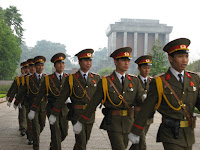
After trekking through the terraced mountains, we climbed back aboard the train, headed back to Hanoi, then south to Hué (pronounced Hway), a small city in the center of Vietnam, dense with history. It seems almost half the city is contained within the walls of the Citadel, the royal capital of Vietnam’s ousted monarchy.
Inside the stone gate, neighborhoods, moats, and pagodas all surround the Forbidden Purple City, the complex once accessible only to the Nguyen kings and his concubines and eunichs. I expected a maze of opulent palaces; I found a grassy field. Fighting during the American War 40 years ago virtually razed the Forbidden City, and like most things unrelated to the Communist party, little has been done to restore it.
The liveliest part of the grounds is the massive koi ponds near the main entrance, where young Vietnamese feed bread to giant fish who flap and scramble over each other, mouths agape, trying to catch the crumbs.
Beyond the palace, Hue is a city remembered for the horrors it endured during the Vietnam War. This legacy is still palpable. The Demilitarized Zone that separated the capitalist south and communist north for much of the mid-20th century is located a few dozen kilometers north. The city bore the brunt of battles along this border, and, today, disgruntled South Vietnamese veterans lead tours to the area, and openly discuss their anger with both the south and the Americans for their abandonment, and the north for their post-war “re-education camps” and prejudicial policies.
Other vets earn their living on the roadside, selling casings from exploded land mines and dog tags belonging, supposedly, to dead American soldiers. Its morbid tourism at its saddest, and made us wonder whether someday I’ll be touring the eastern region of Iran, that was once called Iraq, where locals scrape by selling Hum-V shrapnel. It's an odd mix of history, and one worth experiencing during a trip down Vietnam.
One of the best parts of the Hue visit was renting a motorbike and exploring the nearby surroundings. For $4, plus gas, I headed to Thuan An Bien Gua, a nearby island with chilly, empty beaches strewn with canoes and lined by giant, crashing waves. Equal parts stark and beautiful, fittingly, it looked like a movie set for a grim beach side battle.











